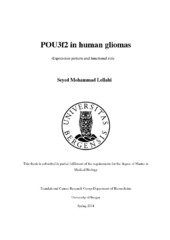POU3f2 in human gliomas - Expression pattern and functional role
Master thesis
Permanent lenke
https://hdl.handle.net/1956/8167Utgivelsesdato
2014-06-02Metadata
Vis full innførselSamlinger
Sammendrag
Gliomas are tumors of the central nervous system (CNS). They are responsible for about 28% of all central nervous system tumors and for 80% of all malignant brain tumors. The most commonly used classification and grading of CNS tumors is the World Health organization (WHO) classification: According to the WHO classification, gliomas are divided into four grades, from grade I to IV. Furthermore, different grade tumors are characterised by different genetic aberrations and phenotypes. Tumor and fetal development display a resemblance due to the fast increase in biomass and extensive cell migration that characterised both processes. Thus the early embryo and tumors may share a common genetic basis. POU domain transcription factors have a critical role in embryo development, and reexpression/overexpression of these transcription factors have been reported in many cancers. POU3f2 is an intronless member of class III POU domain transcription factors. Its expression is confined to the CNS where it is involved in differentiation of neuronal and glial cell lineages in the embryo. Re-expression of POU3f2 has been reported in melanoma cancer by several independent groups. Although POU3f2 expression in gliomas has been sporadically reported, it has not been systematically characterised in a larger panel of gliomas of different grades and histologies. Since melanocytes and the main CNS cell types share a common neuroectodermal origin therefore, we hypothesized that POU3f2 is expressed in human gliomas. In order to assess the expression of POU3f2 in glioma patients, and its possible correlation with malignancy grade, 51 formalin fixed paraffin embedded patient biopsies (grade II-IV) were stained by immunohistochemistry. Secondly, to confirm IHC results, western blotting and qRT-PCR were performed on about 40 human glioma biopsies. In addition, we conducted a series of experiments in vitro and in vivo to investigate how POU3f2 impacted on various aspects of glioma cell behavior. We found that, POU3f2 is expressed in all grades of glioma of both astrocytic and oligodendroglial lineages. Moreover, expression was higher in grade IV than grade II tumors, whereas over-expression of POU3f2 in the U251cell line increased both glioma cell proliferation and colony formation. Conversely, down-regulation of POU3f2 decreased colony formation. Finally, over-expression of POU3f2 in the U251cell line promoted tumor growth in nude mice, compared to U251 glioma cells with down-regulation of POU3f2 or expression of scrambled RNA sequences. My plan for future studies will be to expand the present data to include additional glioma cell lines. In addition, my goal is to establish which signaling pathway mediates the effects of POU3f2.
